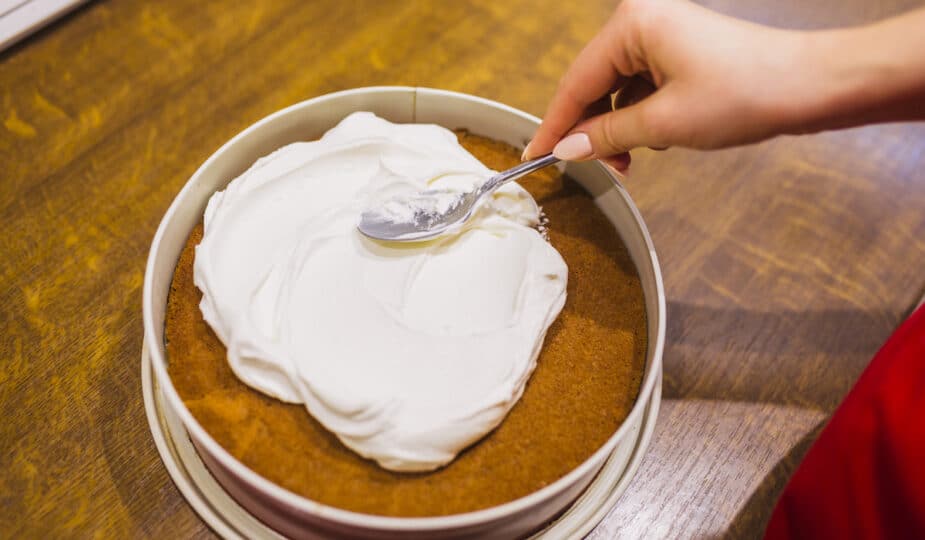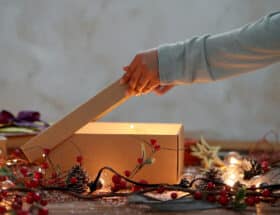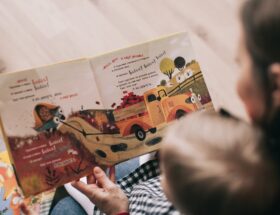By Pauline Weston Thomas for Fashion-Era.com
- Traditional Christmas Recipes
- Modelling Paste
- Edible Sugar Modelling Paste
‡ In the United Kingdom Modelling is the correct spelling, however, I realize that in the USA there is only a single 'l', modeling paste.
Traditional Christmas Recipes
Following on from the theme of A Child's Christmas in Wales, here is a recipe I have used for years to make modelling paste for sugarcraft Christmas decorations for the cake and other items. The recipe can of course be used to model items of sugarcraft for weddings and other special occasion cakes.
Modelling Paste
If you plan to do fancy decorations on the iced cake then start early and prepare your sugarcraft items so that they dry off to be very hard and can be coloured without damage in good time.
In latter years when making cakes for friends as gifts I adopted the plaque method in the picture below, which involves covering a thin or medium thickness cake board of the same size or smaller size than the finished cake. I completely cover the plaque board with fondant icing sugar paste or modelling paste. It needs to be left for a few days to set hard and can be trimmed with narrow ribbon or braid or if to be fixed on the cake edged with shell piping or lacework or whatever pleases you.
I then place the Sugarcraft Xmas arrangement on the plaque and this can be set atop the iced cake.
A dab of icing will secure it and it can simply be removed from the cake before it's cut, keeping the decoration intact to be admired and to be available for use another time or reassembled with slightly different flora.
The holly leaves and very shiny berries on the plaque decoration above, have been glazed with a special glaze for the purpose, giving them the glossiness that real holly leaves and berries have.
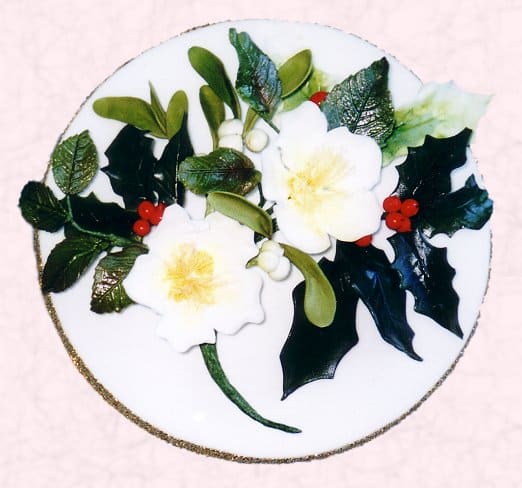
The recipe for modelling sugar paste below was given to me by an expert in sugar craft. This is not the same paste as the fondant paste used to cover the cake. I always simply buy Renshaw's fondant from the supermarket for that. Whitworths also makes a similar paste. True modelling or Mexican paste is harder to find and you may need to visit specialist shops. The internet is a good source for online supplies of sugarcraft materials.
This modelling paste recipe is made in the Microwave and I like it for items where a large number of bases such as buds for roses need to be prepared or figures or bigger items or moulds need to be made. It is ideal for snowmen for example, where using Squire professional sugar paste might become prohibitive cost-wise.
Why? Well, it works out much less expensive than the commercial version and can be made at home on hand at convenience once you acquire the more unusual products like gum tragacanth and liquid glucose.
You can use it for modelling flower petals, but usually when doing sugar craft I also have on hand some Squires sugar paste and the latter makes exceptionally pure white petals for lilies and stephanotis etc. This though is perfect when the petal is coloured either in the paste or by colour dusting.
Likewise I always have a packet of the Squires Xmas red and holly green sugar paste in my workbox as it is difficult to get depth of colour with rich deep colour pastes such as these. The best holly looks like dark green lacquer and the nicest ivy is variegated from pale to dark.
Once for a very special big '0' birthday, I made a chess board cake for my husband using this paste to make the chess figures as it was so much more economical than buying the Squires paste. With time it set very hard. I could not colour it black enough directly in the paste without getting it more than charcoal or a too-wet paste, so I used black food dye to paint each piece twice.
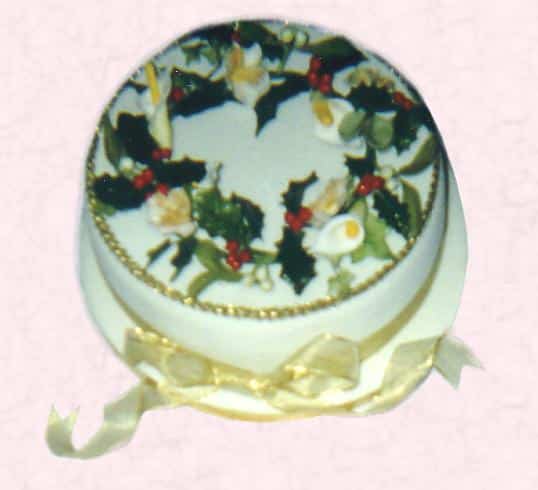
For pure white flowers you cannot in my opinion beat Squires flower paste, but for flowers that need to be white, yet not crystal white and are likely to be tinted this paste recipe is marvellous.
The cake plaque in the header with a poinsettia has been made using a combination of commercial red paste and the mistletoe and berries made with this paste recipe.
The poinsettia is on a double plaque and the cake sides were made to appear quilted using an impression mould. Dragees were added to appear as stitches. Very fine green-coated wires twisted around tubes can create the ivy tendrils that trail. This modelling paste is also economical for items such as the spadix in the calla lilies on this cake. By the time they are coated with coloured sugar the paste need not be the purest of whites.
You are reading an original How to Make Sugar Modelling Paste for Sugarcraft Flowers and Cake Decoration food article by Pauline Weston Thomas at www.fashion-era.com ©.
Edible Sugar Modelling Paste
Microwave Method
Time 15 minutes standing, 15 minutes making, 1 Hour Resting
Ingredients
- 1lb (500gm) of icing sugar (Confectioner's dusting powder)
- 4 teaspoons of powdered gelatine - in the UK this is one packet
- 50 ml water exactly
- 2 teaspoons liquid glucose
- 2 level teaspoons gum tragacanth or use CMC (Carboxy Methyl Cellulose) instead
- 1 teaspoon of Trex, Spry Cookeen or White Flora vegetable type fat
- Note the glucose is essential for elasticity and the gum tragacanth gives hardness and strength.
- 1 wooden Spoon - use for all stirring sieving
- I Pyrex jug
- 1 sieve
- 1 large mixing bowl
- 6 strong polythene freezer bags
- A teaspoon or so of extra white fat.
- Method
Prepare the gelatine by putting the water into a Pyrex jug and sprinkle on the powder gelatine. Stir to mix then allow to stand for at least 15 minutes.
Next sift the icing sugar and gum tragacanth into a large bowl.
Now after the 15 minutes put the gelatine mix in the microwave oven and heat on medium/low setting dependant on oven for 15 to 20 seconds until lukewarm.
Make sure the gelatine is fully dissolved, if it isn't give it a little more heating if required.
Now add the glucose and the white fat and rewarm for 30 seconds ensuring all is dissolved and fully melted.
Mixing up the Modelling Paste
Metal spoons cause greying so use a wooden spoon to make this.
Make a well in the centre of the icing sugar mix and add the warm liquid, pouring it all in at once. Initially mix it with a wooden spoon and then your hands.
The mixture will look all wrong at first sight like threads of cooked poached egg. But keep mixing by hand now until it draws together.
Put some white fat on your hands (more than once if required and knead really well. All of a sudden it will come together and seem like a fondant paste.
Shape it neatly and now cut it into 4 or 5 pieces. Put each piece into a separate strong polythene bag, wrapping the bag around it well, then put those bags into another polythene bag and finally put them all into a strong plastic sealed container.
DO NOT USE CLINGFILM (GLAD WRAP) AS IT MAKES IT WET.
Leave the paste to rest for 1 hour at least, preferably 24 hours before use.
When you make it in sections this paste can easily be frozen 2 hours after making. You can also keep it in the fridge for 2 weeks for normal use.
But I have had best results with this paste by using it within 48 hours of making it.
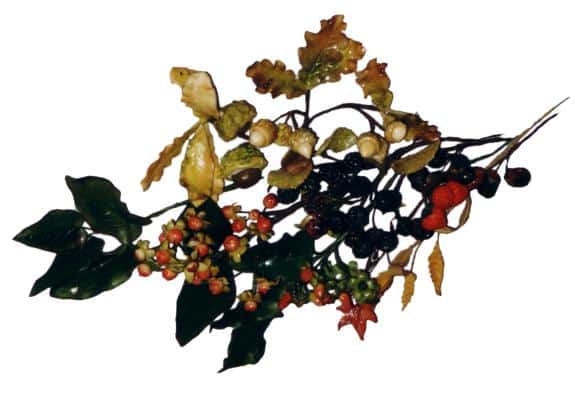
If you know you intend to keep the paste for a fair time smear the thinnest layer of hand warmed white vegetable fat over the surface of each paste section before wrapping up.
Use the paste to make fine flower petals, leaves and holly, snowmen, boxes, stars.
These autumnal leaves, chestnuts, acorns and hypericum (St. John's Wort) berries, maple leaf, wheat stalks and oak leaves were all made by me using this modelling paste recipe.
All items have been dusted with food powders, steamed and when dry glazed with sugarcraft glaze for extra shininess.
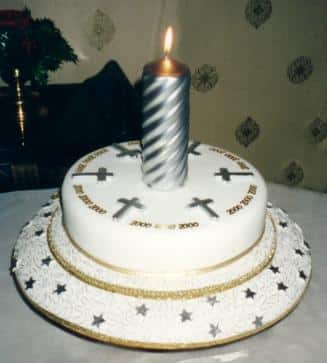
This straightforward cake I made for millennium night uses the simple theme of crosses for Christianity plus a single large celebratory candle which was lit at midnight as the bells rang in the new millennium.
Omit the crosses, and the silver-coated star decoration on the built-up cake board base and random squiggle work would be easy to do all over a Christmas cake.
You have been reading an original How to Make Sugar Modelling Paste for Sugarcraft Flowers and Cake Decoration food article by Pauline Weston Thomas at www.fashion-era.com ©.
‡ In the United Kingdom Modelling is the correct spelling, however, I realize that in the USA it only has a single 'l', modeling paste.
Page Added October 2006
